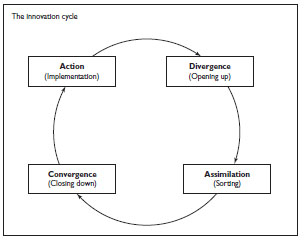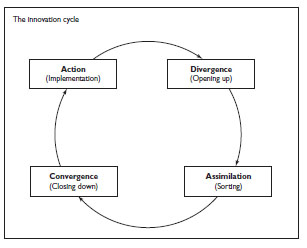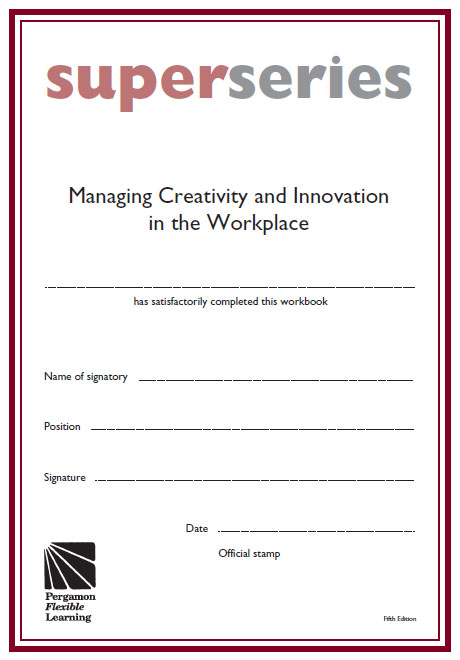•
Now that you have completed your work on Managing Creativity and Innovation in the Workplace, let us review each of our unit objectives.
The first objective was:
![]() Distinguish between creativity and innovation
Distinguish between creativity and innovation
We have used definitions of creativity and innovation that make it clear that innovation depends on creativity. We have also emphasized that everyone has the ability to be creative, given the opportunity, and that a key part of any managers’ role is to take advantage of the creative ability of the people they lead.
Can you readily distinguish between the two ideas?
_______________________________________________________________
_______________________________________________________________
Do you trust in the people you lead to develop creative ideas, given the right opportunity?
_______________________________________________________________
_______________________________________________________________
The next objective was:
![]() Recognize the increasing importance of creativity and innovation in organizational success
Recognize the increasing importance of creativity and innovation in organizational success
We have seen how innovative products and services, and ways of working, have become far more prevalent and that people are far more ready to accept innovation than in the past. We have also seen how hard it is to recognize all the opportunities to be innovative, but all organizations need to have a commitment to creativity and innovation and have systems in place to develop their own creative ideas, and also seek out creativity and innovation from other sources.
How willing are you to try out innovative products and services? Which of the six categories we looked at best describes you?
_________________________________________________________________
_________________________________________________________________
Does your organization actively encourage and seek out creative ideas and innovative processes, products and services?
_________________________________________________________________
_________________________________________________________________
The next two objectives were:
![]() Appreciate some of the different techniques that can help you to lead people through a creative ideas generation process
Appreciate some of the different techniques that can help you to lead people through a creative ideas generation process
![]() Select an appropriate creative approach to developing innovations in your organization
Select an appropriate creative approach to developing innovations in your organization
We looked at several different techniques, four of them in some detail. Although they may look demanding, once you try them you will find they are quite straightforward to use.
Do you feel confident to use any of the different techniques for creative ideas generation?
_________________________________________________________________
_________________________________________________________________
What are you going to do to try any of them out?
_________________________________________________________________
_________________________________________________________________
The final objective was:
![]() Implement innovative ideas in your organization
Implement innovative ideas in your organization
It's one thing to develop creative ideas for new processes, products or services, it's another to put them into practice. We looked at what it takes for an organization to be open to innovative ideas and what you as manager need if you are to be able to do so effectively.
How receptive is your organization to innovation? What characteristics does it have that cause you to make that judgement?
_________________________________________________________________
_________________________________________________________________
Do you believe that you will be able to implement innovative ideas in your organization?
_________________________________________________________________
_________________________________________________________________
•
Use this plan to further develop for yourself a course of action you want to take. Make a note in the left-hand column of the issues or problems you want to tackle, and then decide what you intend to do, and make a note in Column 2.
The resources you need might include time, materials, information or money You may need to negotiate for some of them, but they could be something easily acquired, like half an hour of somebody's time, or a chapter of a book. Put whatever you need in Column 3. No plan means anything without a timescale, so put a realistic target completion date in Column 4.
Finally, describe the outcome you want to achieve as a result of this plan, whether it is for your own benefit or advancement, or a more efficient way of doing things.
•
| Extension 1 | Book | Systematic Innovation: Introduction to the Theory of Inventive Problem Solving (TRIZ) |
| Authors | John Terninko, Alla Zusman, Boris Zlotin | |
| Publisher | St Lucie Press (1998) | |
| Extension 2 | Book | Creative Problem Solving for Managers: Developing Skills for Decision Making and Innovation |
| Author | Tony Proctor | |
| Publisher | Routledge (2005) |
•
| Self-assessment I on page 14 | 1 Creativity is ‘the thinking of novel and appropriate ideas’ whereas innovation is ‘the successful implementation of those ideas within an organization.’ |
2 The innovation gap. |
|
3 Innovators, Early Adopters, Early Majorities, Late Majorities, Late Adopters and Laggards. |
|
| Self-assessment 2 on pages 35-7 | 1  |
2 The rules of brainstorming are as follows:
![]() Make sure the purpose is clear and understood.
Make sure the purpose is clear and understood.
![]() Control the group, make sure everyone takes part and nobody dominates.
Control the group, make sure everyone takes part and nobody dominates.
![]() Every idea is allowed and written up for all to see.
Every idea is allowed and written up for all to see.
![]() Build on the ideas of others, don't discuss or object to them.
Build on the ideas of others, don't discuss or object to them.
3 Two variants on brainstorming are Nominal Group Technique and Trigger Sessions.
4 TRIZ stands for Theory of Inventive Problem Solving.
5 The five inventive principles mean:
1 Segmentation — divide a product into sections that fit together.
2 Extraction — remove something that is causing a problem.
3 Local quality — introduce variations to meet specific requirements of the environment.
4 Asymmetry — make symmetrical objects asymmetric.
5 Combining — link together items that need to work together.
6 The four stages in the TRIZ problem-solving process are:
![]() State the problem
State the problem
![]() Look for an analogous standard problem
Look for an analogous standard problem
![]() Explore the solution to this analogous problem
Explore the solution to this analogous problem
![]() Adapt this solution to your own problem.
Adapt this solution to your own problem.
7 Just 1% of solutions to problems involved a radically new discovery
8 SCAMPER stands for:
![]() Substitute (components, materials, people or processes).
Substitute (components, materials, people or processes).
![]() Combine (things or activities together).
Combine (things or activities together).
![]() Adapt (or change an activity or object).
Adapt (or change an activity or object).
![]() Modify (something, making it bigger or smaller, change its shape or its features).
Modify (something, making it bigger or smaller, change its shape or its features).
![]() Put (something to another use).
Put (something to another use).
![]() Eliminate (something by removing components of stages in a process, simplify things and reduce them to their core functionality).
Eliminate (something by removing components of stages in a process, simplify things and reduce them to their core functionality).
![]() Reverse (something, turning inside out or upside down, or ask how you would do the reverse of what you want to do, to suggest how to do it better).
Reverse (something, turning inside out or upside down, or ask how you would do the reverse of what you want to do, to suggest how to do it better).
9 Synectics is based on bringing together contradictory or very different ideas in order to generate a creative solution to a problem.
10 Two other techniques similar to synectics are Lateral thinking and Random juxtaposition.
| Self-assessment 3 | 1 |  |
2 What are the two questions you should ask to decide on the viability of creative ideas?
1 Would they work?
2 Can this organization make them work?
3 Thomas Kuhn claled the dominant mindset that shapes how scientists respond to new ideas, a paradigm
4 Four techniques to judge the ideas from the creative ideas process:
![]() Hurdles
Hurdles
![]() Ranking
Ranking
![]() Weighting
Weighting
![]() Instinct
Instinct
5 The two types of technical innovation identified by CEST were:
![]() evolutionary innovation
evolutionary innovation
![]() revolutionary innovation
revolutionary innovation
6 The three core competences required for innovation are:
1 technological — the ability to develop new ways of working and new products or services;
2 entrepreneurial — the willingness to try out new ideas and take risks; and
3 learning — the ability to learn from the innovative experience
7 Any organization that is ready to embrace innovation must have the technical ability to develop new ways of working and new products or services, the entrepreneurial will to try out new ideas and take risks, the ability to learn from experience, and an understanding of the needs of users. They also pay attention to marketing, their development work is undertaken efficiently and they have a strong commitment to evolutionary development.
8 According to Rosabeth Moss Kanter, the power to bring about innovatory change relies on:
![]() Information
Information
![]() Resources
Resources
![]() Support
Support
9 The three main approaches to implementing innovations in organizations are:
![]() Mission-oriented
Mission-oriented
![]() Negotiaiton
Negotiaiton
![]() Action research
Action research
•
Activity 17
Our order |
Our reasons |
|
| 1. | Financial Services Authority must be prepared to licence us to offer it. | If they can't be licensed then there is no point in continuing with the idea. |
| 2. | Customers must think us a suitable source. | It is hard — and expensive — to change customer opinions. |
| 3. | No other organizations dominate the market. | If there is a dominant supplier then they will be facing a hard battle to get established. |
| 4. | We must already have the skills to offer it. | Useful but not essential — skills can be learned or staff recruited. |
| 5. | Must be able to be supplied via the Internet. | Again, this is useful and, in the long run, may be essential, but the Internet only accounts for a fraction of the market, even if it's growing, and some customers are still not that keen on using it. |
You may have put some of these in different orders — 2 and 3 could be swapped, as can 4 and 5, but the general order reflects increasingly demanding hurdles that really sort out the ideas.
Activity 18
Our rank order
1 Offer to deliver to workplaces.
2 Ask for a neighbour's name and address as an alternative delivery address.
3 Use a tamper-proof container that can be locked to the letterbox with a release code that can be sent by text when the person requests it.
4 Deliver in the evenings and weekends.
5 Use local delivery points, such as post offices, for people to collect their items in their own time.
You may have come up with something different, but see how your answers compare with ours and think about why they may differ.
| Characteristics | Our weights for each | |
| Financial Services Authority must be prepared to licence us to offer it | 5 | |
| We must already have the skills to offer it | 1 | |
| Customers must think us a suitable source | 4 | |
| Must be able to be supplied via the Internet | 2 | |
| No other organizations dominate the market | 4 |
You may have come up with something different, but see how your answers compare with ours and think about why they may differ.
•
| Level | Level of inventiveness | Source of knowledge | |
| 1 | Routine solution, no NOVELTY | Personal knowledge | |
| 2 | Minor improvement, some novelty | WITHIN ORGANIZATION | |
| 3 | MAJOR IMPROVEMENT, quite novel | Within the industry | |
| 4 | New concept, very novel | OUTSIDE THE INDUSTRY | |
| 5 | Discovery, RADICALLY NEW | ‘All that is knowable’ |
•
Completion of this certificate by an authorized person shows that you have worked through all the parts of this workbook and satisfactorily completed the assessments. The certificate provides a record of what you have done that may be used for exemptions or as evidence of prior learning against other nationally certificated qualifications.
super series
FIFTH EDITION
Workbooks in the series:
| Achieving Objectives Through Time Management | 978-0-08-046415-2 |
| Building the Team | 978-0-08-046412-1 |
| Coaching and Training your Work Team | 978-0-08-046418-3 |
| Communicating One-to-One at Work | 978-0-08-046438-1 |
| Developing Yourself and Others | 978-0-08-046414-5 |
| Effective Meetings for Managers | 978-0-08-046439-8 |
| Giving Briefings and Making Presentations in the Workplace | 978-0-08-046436-7 |
| Influencing Others at Work | 978-0-08-046435-0 |
| Introduction to Leadership | 978-0-08-046411-4 |
| Managing Conflict in the Workplace | 978-0-08-046416-9 |
| Managing Creativity and Innovation in the Workplace | 978-0-08-046441-1 |
| Managing Customer Service | 978-0-08-046419-0 |
| Managing Health and Safety at Work | 978-0-08-046426-8 |
| Managing Performance | 978-0-08-046429-9 |
| Managing Projects | 978-0-08-046425-1 |
| Managing Stress in the Workplace | 978-0-08-046417-6 |
| Managing the Effective Use of Equipment | 978-0-08-046432-9 |
| Managing the Efficient Use of Materials | 978-0-08-046431-2 |
| Managing the Employment Relationship | 978-0-08-046443-5 |
| Marketing for Managers | 978-0-08-046974-4 |
| Motivating to Perform in the Workplace | 978-0-08-046413-8 |
| Obtaining Information for Effective Management | 978-0-08-046434-3 |
| Organizing and Delegating | 978-0-08-046422-0 |
| Planning Change in the Workplace | 978-0-08-046444-2 |
| Planning to Work Efficiently | 978-0-08-046421-3 |
| Providing Quality to Customers | 978-0-08-046420-6 |
| Recruiting, Selecting and Inducting New Staff in the Workplace | 978-0-08-046442-8 |
| Solving Problems and Making Decisions | 978-0-08-046423-7 |
| Understanding Change in the Workplace | 978-0-08-046424-4 |
| Understanding Culture and Ethics in Organizations | 978-0-08-046428-2 |
| Understanding Organizations in their Context | 978-0-08-046427-5 |
| Understanding the Communication Process in the Workplace | 978-0-08-046433-6 |
| Understanding Workplace Information Systems | 978-0-08-046440-4 |
| Working with Costs and Budgets | 978-0-08-046430-5 |
| Writing for Business | 978-0-08-046437-4 |
| For prices and availability please telephone our order helpline | +44 (0) 1865 474010 |
| or email | [email protected] |



